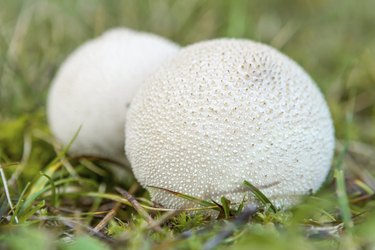
Puffballs, a type of fungus, sometimes pop up in lawns, often after a rainy period during warm summer weather. Puffballs range from small, 1-inch-wide ones to giant puffballs more than 40 inches in diameter that can weigh 50 pounds. Most puffballs are white or cream-colored, but some can have a purplish tinge. Puffballs aren't harmful to lawns, but they are toxic if eaten, so it's important to get rid of them as soon as you see them.
Types of Puffballs
Video of the Day
Different species of puffballs grow in different parts of the U.S. Some puffballs, such as those of the genus Lycoperdon, occur more in forests or wildlands. For lawn puffballs, the largest puffballs are the giant puffballs (Langermannia gigantea), which grow in the eastern U.S., and Western giant puffballs (Calvatia booniana), which occur in the western states, mostly in drier areas, and have raised tan spots. The skull-shaped puffball (Calvatia craniformis) is another eastern species, displaying wrinkles at the base of the puffball. A pinkish-tan color identifies the purple-spotted puffball (Calvatia cyathiformis), and the pyramid puffball (Calvatia sculpta) has pyramid-shaped warts. Few puffballs live in the South and the Gulf Coast states.
Video of the Day
Where Puffballs Come From
Unseen beneath the soil of your lawn, the fungi that produce the puffballs are quietly helping to break down decaying organic matter in the soil. They're providing a necessary service to recycle dead plant material back into the nutrients needed by growing plants. The fungi start as threadlike growths called hyphae, which usually can't be seen except with a microscope. Sometimes the hyphae come together in a mass called a mycelium that you can see. It usually resembles a tangled bunch of light- or dark-colored threads. Often you can see fungal mycelia on dead wood. When conditions are right, like after a rain, the hyphae form a fruiting body that will grow to form spores, which are then released to the air. The puffball is a fruiting body.
Growth of a Puffball
Puffballs start out small, and how fast they grow depends on the species. The larger species can exert quite a bit of pressure on the soil around them as they quickly expand. The Press of Atlantic City reports on puffballs that break through asphalt, sidewalks and swimming pool liners as they emerge. The young puffballs are firm both inside and outside. As they mature, the insides soften and form the spore-producing tissue. At maturity, the puffball is dry inside and filled with many tiny, light spores. The spores are released when the puffball splits or breaks open, releasing the spores to be carried on the air. Sometimes they issue out of the fruiting body like puffs of smoke.
Controlling Puffballs
Because the naturally existing fungal hyphae that produce puffballs grow over a large area under the lawn, there's no real way to control them. All puffballs can be toxic if eaten, so it's important to keep curious kids and pets away from them. Remove puffballs while they are still young and firm. There's no way of keeping puffball spores from entering the soil, because they can travel for long distances.
- UC Statewide IPM Online: Mushrooms and Other Nuisance Fungi in Lawns
- Bayer Advanced: Lawn & Landscape: Get Rid of Mushrooms in Your Lawn
- PressofAtlanticCity: Puffballs and Fairy Rings Can Destroy Lawns and Driveways
- University of Hawaii Extension: Spore Dispersal in Fungi (Continued): Mushrooms & Puffballs